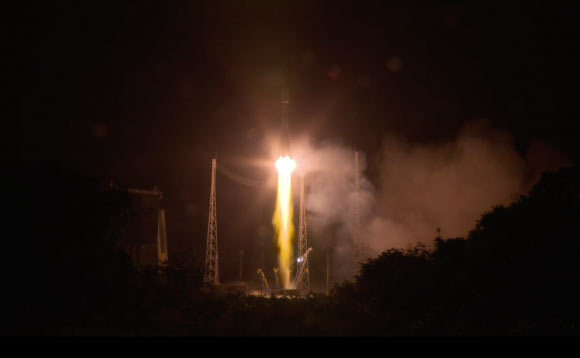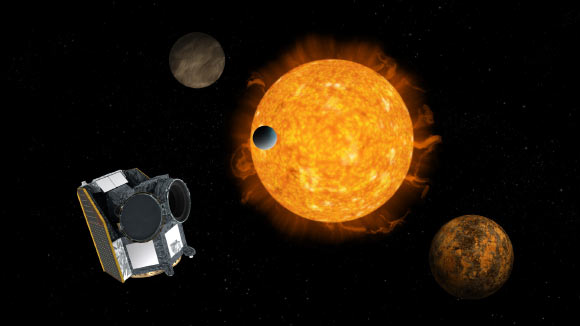ESA Launches Exoplanet-Studying Satellite Cheops | Astronomy – Sci-News.com
The CHaracterising ExOPlanet Satellite (Cheops) — the first mission of the European Space Agency (ESA) dedicated to the study of exoplanets — lifted off from Europe’s Spaceport in Kourou, French Guiana, at 09:54 CET on December 18, 2019.

ESA’s Cheops spacecraft lifts off from Europe’s Spaceport in Kourou, French Guiana. Image credit: ESA.
Cheops is a partnership between ESA and Switzerland, with important contribution from Austria, Belgium, France, Germany, Hungary, Italy, Portugal, Spain, Sweden, and the United Kingdom.
The spacecraft will observe bright stars hosting planets in the Earth- to Neptune-size range, measuring tiny brightness changes due to the planet’s transit across the star’s disk and yielding precise measurements of the planet sizes.
This, together with independent information about the planet masses, will allow astronomers to determine their density, enabling a first-step characterization of these alien worlds.
A planet’s density provides vital clues about its composition and structure, indicating for example if it is predominantly rocky or gassy, or perhaps hosts global oceans.
Unlike previous exoplanet satellites, such as NASA’s Kepler and TESS missions, Cheops is not a ‘discovery machine’ but rather a follow-up mission, focusing on individual stars that are already known to host one or more planets.
The mission also has the capability to discover previously unknown planets by measuring tiny variations in the timing of the transit of a known planet, and can also be used to search for moons or rings around some planets.
Cheops will also identify the best candidates for detailed study by future missions and observatories. For example, it will provide targets for the NASA/ESA/CSA James Webb Space Telescope, which will be used to search for the signatures of water and methane, important elements in our quest for habitable words.
“Cheops will take exoplanet science to a whole new level,” said Dr. Günther Hasinger, Director of Science at ESA.
“After the discovery of thousands of planets, the quest can now turn to characterization, investigating the physical and chemical properties of many exoplanets and really getting to know what they are made of and how they formed.”

An artist’s impression of Cheops with an exoplanet system in the background. Image credit: ESA / ATG Medialab.
“We are very excited to see the satellite blast off into space,” said Cheops project scientist Dr. Kate Isaak, of ESA.
“There are so many interesting exoplanets and we will be following up on several hundreds of them, focusing in particular on the smaller planets in the size range between Earth and Neptune.”
“They seem to be the commonly found planets in our Milky Way Galaxy, yet we do not know much about them.”
“Cheops will help us reveal the mysteries of these fascinating worlds, and take us one step closer to answering one of the most profound questions we humans ponder: are we alone in the Universe?”






